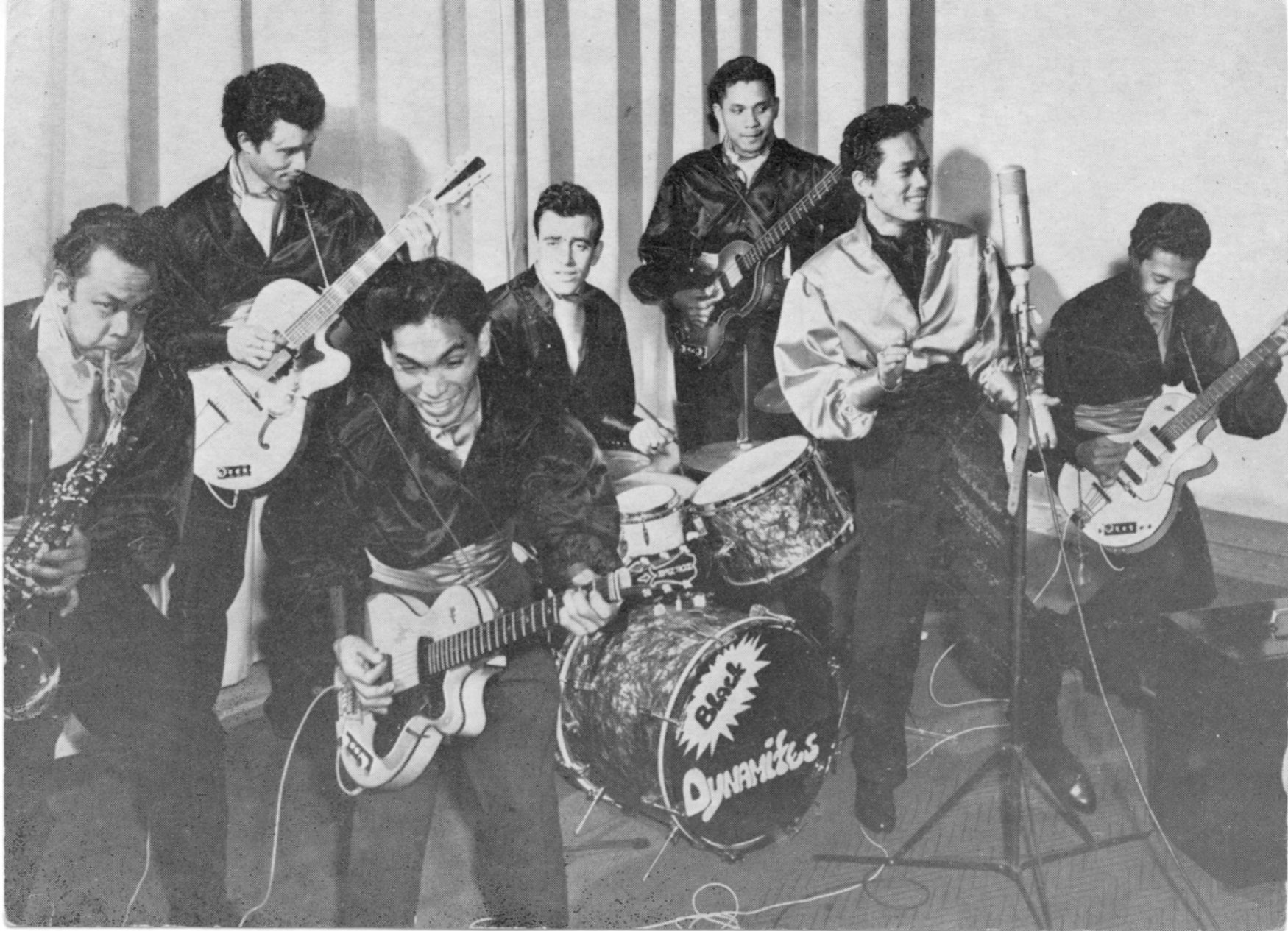The cradle of Dutch pop music
Peter Breedveld

The Black Dynamites
In the sixties The Hague was thé Duch pop city. Two thousand bands were active in the city, many of them have been dominating the Dutch popscene for many years: the Golden Earrings, Groep 1850, the Motions, Q 65, Shockin’ Blue, de Shoes en the Tee Set are just a few examples. But why did The Hague, of all places, turn into the Mecca of Dutch pop music?
Journalist Sarah Verroen, born and bred in The Hague, compares the situation to the English city Liverpool, city of the so-called Mersey Beat. The Liverpool working class brought forth hundreds of bands in the sixties, of which The Beatles are the best known.
Most of the bands in The Hague came from the same neighbourhood, Verroen points out. This was the Zuiderpark neighbourhood, where labourers, office workers and shopkeepers lived. It’s the classic story, Verroen says. Those who wanted to escape the social environment of their parents, had the choice between a cerreer in crime, as a soccer player or in pop music.
Indo rock

The Bellboys playing in The Hague
But labourers, office workers and shopkeepers are everywhere in Holland. Why wasn’t Amsterdam or Rotterdam or Oss the cradle of Dutch pop music? The answer to that question isn’t so difficult: Since the fifties The Hague was a typically Indo-European city. After the independance of Indonesia many thousands of inhabitants from the former Dutch colony came to Holland, many of them to The Hague specifically, and in the weekends there was always at least one Indo-European party taking place somewhere, in one many of the dance halls that The Hague had in those times. Music was played by Indo-European youngsters, a mixture of Rock n’ Roll and so-called kroncong’, an Indonesian type of popular street music. This mixture would soon become known as Indo rock’.
One of the first and most well known Indo rock bands was The Bellboys, later rechristened into The Black Dynamites. The Bellboys played a form of rock n’roll that was completely unknown in the Netherlands. We were ahead of the Dutch, sax player Harry Koster of the Bellboys, now 72 years old, says. In Indonesia we listened to Australian radio stations that played Les Paul and Mary Ford. Koster arrived in Holland in 1952 already, and Indo Europeans who left Indonesia after him had been introduced to the music of Little Richard, Bill Haley and Elvis Presley. The roughest music that was played on Dutch radio at the time was by Cliff Richard and The Shadows.
Indo-European and Dutch kids seldom met each other in the same bars. An outright racist policy was followed by most bar owners and Indo-Europeans were refused. In reaction Indo-European founded clubs where Dutch kinds weren’t allowed. On top of that a couple of youth gangs were active in The Hague, among which the Bullen’, with their leather jackets, the Kikkers’, who were more artistically inclined and the Indo-European Plu’s’. Social workers brought them together in club houses. One of them, Henny Heutink, who was the drummer of The Black Dynamites, organised dance evenings in his club Extase’ on the Groenmarkt.
Preachers

The Black Dynamites
Roman-Catholic preachers were also very active in this field. Everywhere in The Hague they organised get-togethers where kids were even allowed to play their devilish Rock n’ roll. Our goal was to try to make these boys realise that they were worth something, the now 71-year old preacher Harry Kanters explains. When they said they couldn’t do anything we asked them: Can you whistle? Yes? Well, then apparently you cán do something’. Especially the Wednesday afternoons in the catholic youth centre Don Bosco were hugely popular. It was here that many Dutch kids were introduced to Indo Rock.
One of them was Hans van Eijk. In 1956, I must have been thirteen or fourteen, I was a regular visitor of Don Bosco, Van Eijk says. This is where I heard an electrical guitar for the first time in my life. Van Eijk played the guitar himself a little, but this was of a whole different order. These Indo-European boys had a refreshing view on music. For me their music was a real eye opener.
Van Eijk mastered the Indo-European way of playing music and in 1959 he founded The Jumping Jewels, together with singer Johnny Lion, whom he had met at Don Bosco a year before. The Jumping Jewels is one of the pioneering bands of the so-called Haguean Beat (Haagse Beat) movement. More about that further on. Besides Holland the band was very successful in France, Japan and Singapore too.

The Jumping Jewels
Johnny Lion scored a few solo hits with after he left the band in 1965. Hans drew a lot of attention with his guitar playing, Lion says about Van Eijk. People stood pushing in crowds around him, anxious to not miss a thing. Among those enthusiastics were a very young George Kooijmans and Rinus Gerritsen, founders of the Golden Earrings (later the Golden Earring), flagship of the Haguean Beat, which would score an immensely successful number one hit in America with Radar Love and still thé most celebrated rock band in Holland.
Scum
Another pioneer of the Haguean pop music, Willy Wissink, was twenty years old in 1958 when he saw the Tielman Brothers, Indo Rockers from the Dutch city Breda, play in a hall in the Zoo of The Hague. Wissink could barely believe his eyes and ears. These fellows looked kind of rough, with large sideburns. Their music was very rebellious. I thought: What kind of scum is thát?’, Wissink recounts.

The Tielman Brothers
He was so impressed that he started his own Rock n’ Roll combo’ as it was called in those days. Under the name of Willy and the Real Rhythm Rockers, later The Real Rhythm Folks he played at dance evenings that he organised himself in the canteen of a roller-skating rink and which attracted a large public. Later Wissink went to play with another band, The Giants, from then on Willy and his Giants, that was successful especially in East Asia.
But Wissink had some unfortunate encounters with shady managers and record bosses and in the second half of the sixties he quit disillusioned. That beat music, that became popular then, wasn’t exactly my cup of tea either, Wissink says now. Too much noise, barely any melody. Willy and his Giants are an almost forgotten band now, but according to some connoisseurs Wissink is The Godfather of Haguean Rock’.
It was only at the beginning of the sixties that pop stations like Radio Luxemburg began to be broadcasted on Dutch radio. British bands like The Beatles became known to the Dutch public. Their beat music, characterised by a simple, guitar-dominated line-up, vocal harmonies and catchy tunes, inspired the Haguean Beat movement.
Bar and dance hall owners cleverly hooked on to this new rage. There wasn’t a bar, dance school, club, bowling centre or roller-skating rink that hadn’t a band playing. The entire business scene in The Hague profited from it. Record stores and retailers of musical instruments and equipment expanded spectacularly and also became meeting places for aficionados of pop and rock.
Another factor that is not to be dismissed when studying the history of Haguean pop music is the enterprising spirit of some energetic fellows. They managed and promoted bands, were constantly looking for new talent and organised gigs. Paul Acket, who would later organise one of the most reputed jazz festivals in the world, the North Sea Jazz festival was one of them. He organised pop festivals and teenage shows in the sixties and founded magazines like Muziek Express and Popfoto which followed the latest developments in pop music.

The Golden Earring
Herman Batelaan en Freddie Haayen are two other key figures of the Haguean pop scene. Gifted with a fine nose for talent and a combination of business instinct and the proverbial Haguean bluff they promoted bands like The Jumping Jewels, The Motions and Q65.
Herman Batelaan had a laundrette in the Zuiderpark neighbourhood en acted as the driver for Willy and his Giants, of which his cousin Henk Smitskamp was the bass player. When he saw the Jumping Jewels play he offered to act as their manager. Later he became a kind of talent scout for record company Phonogram.
Legendary is the story of Freddie Haayen, who was only a store clerk but acted like the boss of record company Polydor. Because of his fancy glasses people believed him, and that’s how he managed to get a record deal for the Golden Earrings.
Many thanks to Piet Muys
English, Peter Breedveld, 26.03.2005 @ 11:37






 RSS
RSS